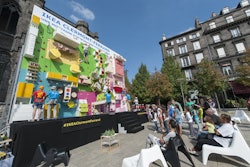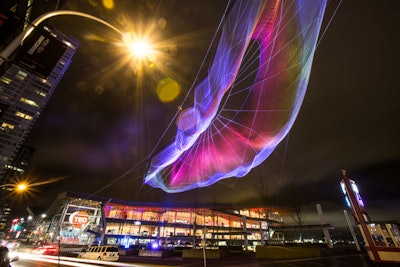
Artist Janet Echelman and Google Creative Lab's Aaron Koblin installed an eye-popping aerial sculpture at the TED Conference in Vancouver. The sculpture was suspended 745 feet between the 24-story Fairmont Waterfront and the Vancouver Convention Center for an unmissable visual centerpiece more than twice the size of the artist's largest previous sculpture. Passersby could use their cell phones to control the piece's lighting, which was provided by Graphics eMotion and Kinetic Lighting.
Photo: Bret Hartman
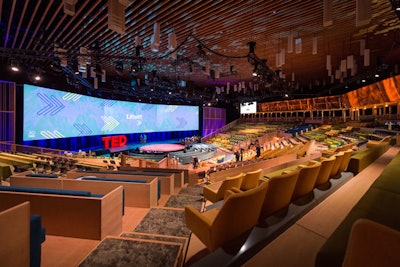
The conference's iconic short talks took place in a 1,200-seat theater that was constructed from thousands of laser-cut pieces. The goal of the temporary, David Rockwell-designed space was to make the convention center space feel more exclusive and on-brand. The theater was designed to be dismantled and stored until the next incarnation of the event.
Photo: Ryan Lash
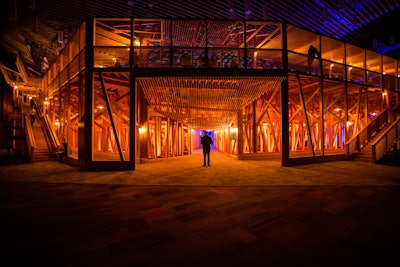
The Rockwell theater was delivered by 50 trucks and set up over about five days. It included an array of different kinds of seating in various arrangements, and the furniture was designed specifically for the space.
Photo: Ryan Lash
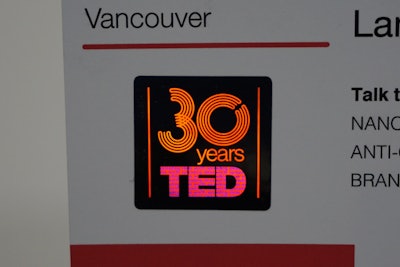
Nanotech Security Corporation created the badge for TED attendees, incorporating the company’s KolourOptik nanotechnology as a security feature. The technology produces optically variable images that can be applied to any surface for anti-counterfeit and branding purposes, and it captures and reformulates light waves into intense colors without pigment or dye. "This year’s TED participants have one of the most technologically advanced conference ID badges ever made. The badges feature images that are imprinted with over 50,000 dpi resolution; that’s 150 times sharper than Apple’s Retina display,” Nanotech C.E.O. Doug Blakeway said in a statement.
Photo: Courtesy of Nanotech
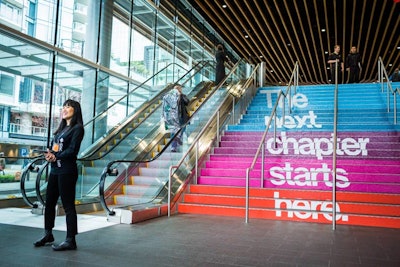
The Vancouver Convention Center's stairs featured color-blocked sections printed with the conference's tagline, "The next chapter starts here," which could be viewed from a distance.
Photo: Bret Hartman
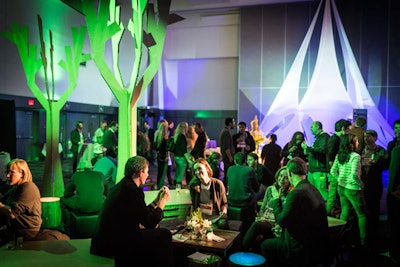
The TED Conference's opening night event took place at the Vancouver Convention Center East, where decor brought the outdoors inside—underscoring the landscape of the event's new home. Tensile and cardboard structures evoked mountains and trees, while the lighting mimicked the northern lights on the mountains. Vintners led a wine tasting, and the menu showcased local, fresh, and clean dishes.
Photo: Bret Hartman
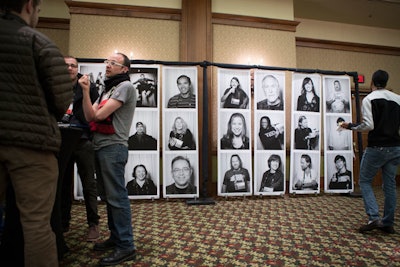
In the TEDActive photo studio, attendees could snap their portraits and share the ideas that they represented. The life-size photos were printed and hung up in the lunch area.
Photo: Marla Aufmuth

TED's social spaces are intended to facilitate interaction, from casual to more structured opportunities. At the conference, five Skype Conversations—including a session titled "Power and Potential of Kickstarter" (pictured)—featured former TED speakers and guests from the TED community.
Photo: Bret Hartman
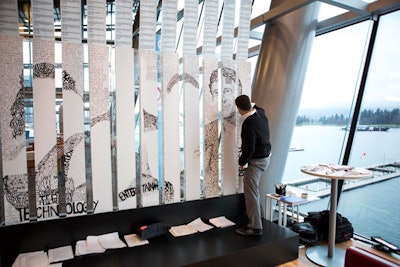
In Target's "Write the Next Chapter" social space, artist Daniel Duffy drew portraits of speakers using their quotes.
Photo: Bret Hartman

In just one of many examples of how TED—and in particular TEDActive—is unlike a typical, buttoned-up conference, a TEDActive attendee organized an impromptu dance party on the stage in Whistler.
Photo: Marla Aufmuth
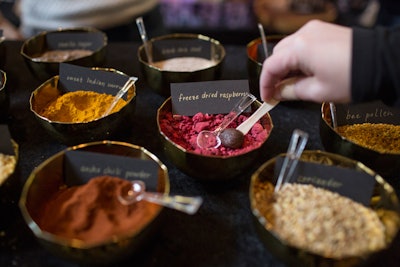
At TEDActive, even the snack breaks came with an interactive touch and a flair of global relevance: Attendees dipped chocolate in Indian spices at the Vosges chocolate table.
Photo: Sarah Nickerson

Through the TEDActive Collaboration Project, hosted by Office 365 and facilitated by Ideo, Microsoft convened a team of 15 TEDx organizers for a workshop to discuss collaborative technology solutions. The team came together to find new technology solutions to update the TEDx Wiki (the site where all of the organizers' templates, case studies, notes, and best practices live).
Photo: Sarah Nickerson
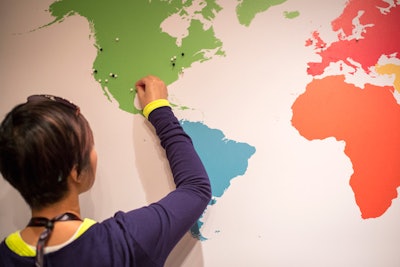
Steelcase hosted a pre-conference workshop at TEDActive called “Culture: Why Does It Matter?” Attendees experienced an interactive display based on global Steelcase research about culture and the workplace and could see where they ranked on the “6 Dimensions of Culture” in relation to other TEDActive attendees. The installation was created to help fuel the conference's weeklong conversations.
Photo: Sarah Nickerson

Educators, education specialists, designers, and students gathered outside the TEDActive main theater to brainstorm around the Robin Hood Foundation College Success Challenge. In partnership with Ideo, Robin Hood debuted a challenge to TEDActive attendees: help design a scalable, technology-driven way to encourage more community college students to successfully graduate with associates' degrees. The group conceptualized real-world solutions throughout three workshop sessions during the week.
Photo: Sarah Nickerson

At TEDActive, the TEDx Action Lab was a space for the 300-plus TEDx organizers from around the world to convene, watch TED talks, and share messages on a giant, evolving chalkboard.
Photo: Marla Aufmuth
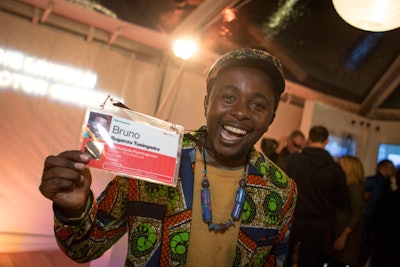
TEDActive's can't-miss oversize name badges are among the many ways the annual event encourages interaction versus more passive attendance.
Photo: Marla Aufmuth
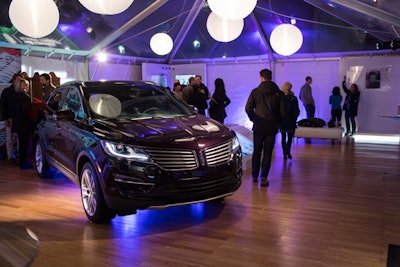
The Lincoln House of Design was a place for the carmaker and conference sponsor to honor the innovative thinkers that participate in its Reimagine Project. For instance, the Sketchbook Project, a collection of more than 30,000 sketchbooks submitted by artists from around the world, was a collaboration between wife-husband duo Sara and Steven Peterman. And TED fellow Christine Sun Kim displayed an installation made of piano wires that have been reimagined as speakers to sound out voice.
Photo: Marla Aufmuth
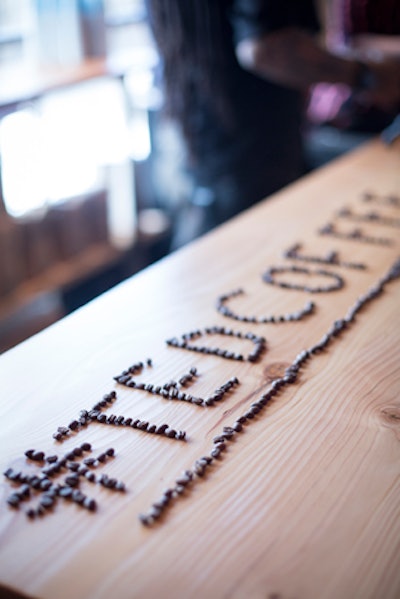
The baristas providing the coffee service at both conferences used a new machine by La Marzocco. Coffee beans spelled out the hashtag #TEDCoffee so that the company could promote its presence at the event and facilitate a conversation around it—one of countless creative social media prompts and integrations.
Photo: Sarah Nickerson
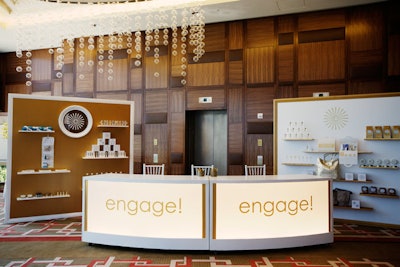
At the hotel, the registration area was set up to resemble a boutique, displaying the items included in the welcome totes on shelves. “At the previous Engage! conference, we found out that some people didn’t open their welcome bag until they got home, but it included a lot of items meant to be used at the conference,” says Arak-Kanofsky. “So we wanted to make sure people knew what was inside. The merchandise walls created by Bob Gail Special Events allowed guests to see what they were getting.”
Photo: Readyluck
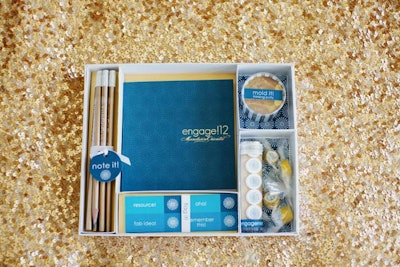
The boxes included pencils, sticky notes, a journal, mints and candy, and “Thinking Putty," a Silly Putty-like product to keep guests’ hands engaged. “We wanted to make all of the gifts as lightweight as possible so that people would be able to take them home in their luggage,” says Susan Arak-Turnock. To that end, the boxes were made from thick paper board.
Photo: Readyluck






